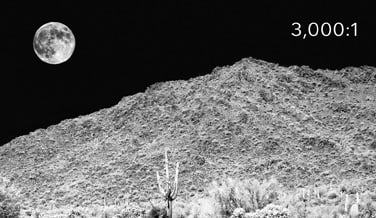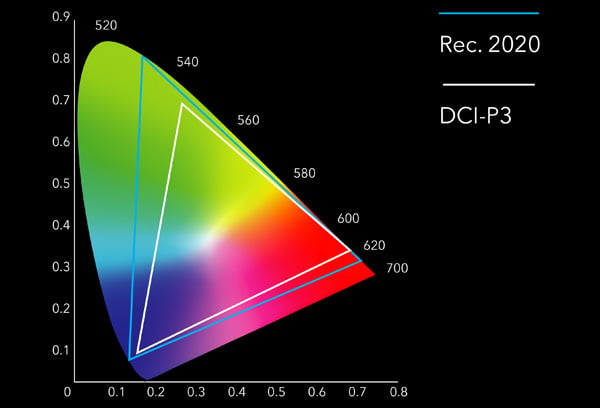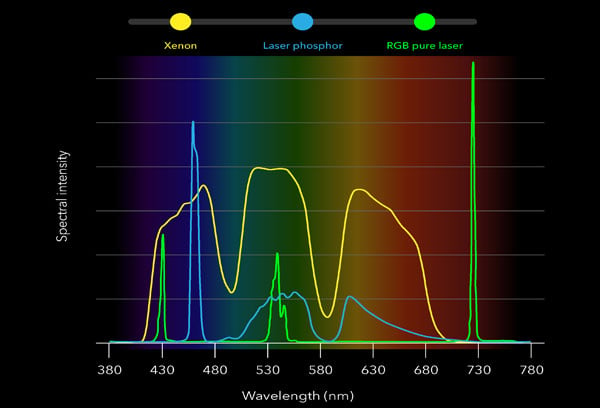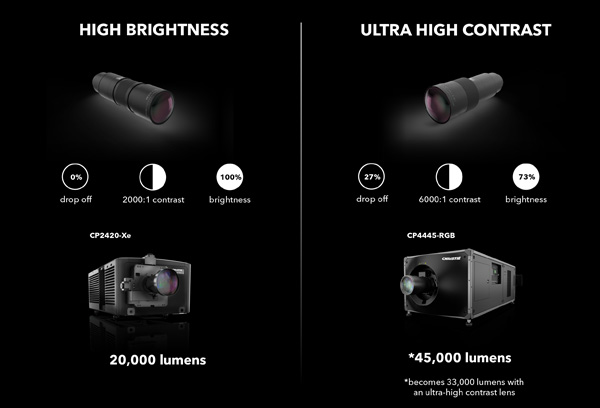
Accurate color reproduction is essential to portraying the director’s intent. To ensure that happens, the industry requires the DCI-P3 color gamut. In 2007, DCI introduced DCI-P3 as a standard minimum for digital projection in commercial cinemas. It’s considered a very wide gamut that’s capable of reproducing a broad range of colors – specifically a much wider range of greens and reds, which is important for reproducing natural landscapes, skin tones, and other elements of the natural world. In the early days of digital cinema, DCI-P3 was the best option available, but it’s now the minimum.
If color dazzles, contrast sets the mood. All cinema illumination types meet DCI-standard 2,000:1 contrast. That means the white light reflecting from the screen needs to be 2,000 times brighter than light that reflects from a purely black scene. The higher the contrast, the more accentuated the white and black ends of the color spectrum. High contrast lenses are the best way to raise contrast, however, they also reduce brightness. RGB pure laser projectors combined with ultra-high contrast lenses produce up to 6,000:1 contrast but causes a loss of around 27% brightness.
High-contrast lenses decrease reflections of scattered light inside the projector that reduce image contrast. Decreasing these reflections increases contrast. Ultra-high contrast lenses further enhance contrast in laser projectors because they project collimated light, which is easier to control than scattered light.
Premium lenses have more space between the edge of the lens and the area through which the image passes, which produces sharper, clearer visuals. The center of a lens offers the best image quality, and because premium lenses have a larger diameter, the image occupies more of the center area and less edge space, where the quality drops. Premium lenses are available that offer high brightness, high contrast, and ultra-high contrast.
Compared to all other light sources, Xenon light most closely resembles sunlight. This is important for reproducing a natural-looking onscreen image. Xenon lamps produce DCI-P3 color. Since the 1970s, most cinemas have shown movies using Xenon, so audiences are most familiar with this type of illumination source. Xenon is still a favorite among many cinemas, post-production studios and film festivals as the tried-and-true workhorse of the cinema.
RB laser phosphor projectors are available in a range of options that use lasers and a phosphor wheel to achieve the DCI-P3 color spectrum without needing as many dedicated laser sources as RGB pure laser. For instance, RB-laser uses red and blue lasers for dedicated hues and shines the blue laser through a yellow phosphor wheel to create green light in lieu of a dedicated green laser source. Additionally, this type of laser phosphor can achieve 3000:1 contrast.
RGB pure laser can produce trillions of additional colors as it reproduces more than 95% of the Rec. 2020 color space, which encompasses almost all colors that a human eye can see. Rec. 2020 is a much wider color space than DCI requires for digital cinema projection. Using direct red, green, and blue lasers to project dedicated colors, RGB pure laser illumination offers the widest range of color and the highest contrast available to cinema exhibitions.



Footnote: ANSI contrast, an alternative to sequential contrast measurement, uses a white and black checkerboard pattern where both white and black measurements are taken from a single image on the screen simultaneously.

Rec. 2020 offers trillions of additional colors compared to DCI-P3, creating an even more emotional and engaging experience for audiences.
Digital cinema is a relatively new technology, having truly come online within the last 20 years. As is the nature of innovation, what was once the industry standard shifts from premium quality to bare minimum. Most cinema screens are still lit by Xenon lamps that produce a light wavelength that’s very similar to daylight and achieve close to DCI-P3 color with at least 2,000:1 contrast. Although RGB pure laser projectors are available at a base level to accompany Xenon in this space, they can deliver a much more immersive and impressive onscreen display. As you can see in this chart, RGB pure laser projection has the optimal balance of primary colors to achieve more than 95% of the vastly wider Rec. 2020 gamut.


Finding the right balance is important. For high-contrast presentations, you'll need a projector capable of producing enough brightness to compensate for any losses caused by higher-contrast lenses. For example, an RGB pure laser projector with an ultra-high contrast lens requires 27% additional brightness. Consider this, in addition to brightness headroom best practices. The CineMaster cinema calculator tool can help you select the right projector.
The capabilities of the three types of cinema illumination vary widely. Xenon reliably achieves minimum requirements but can’t reach the peaks that RGB pure laser illumination can achieve. And where RB laser phosphor reaches limitations, RGB pure laser is truly cinema’s illumination source of the future.